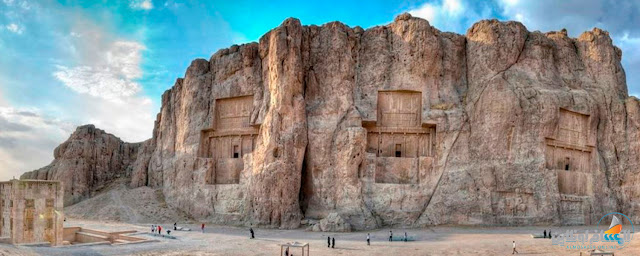Naghsh’e Rostam (نقش رستم) is an archaeological site located about 12 kilometers northwest of Persepolis, in Fars province, Iran. Naghsh’e Rostam lies a few hundred meters from Naghsh’e Rajab.
The oldest relief at Naghsh’e Rostam is severely damaged and dates to c. 1000 BCE. It depicts a faint image of a man with unusual head-gear and is thought to be Elamite in origin. The depiction is part of a larger mural, most of which was removed at the command of Bahram II. The man with the unusual cap gives the site its name, Naghsh’e Rostam because the relief was locally believed to be a depiction of the mythical hero Rostam.
Four tombs belonging to Achaemenid kings are carved out of the rock face. They are all at a considerable height above the ground. The tombs are known locally as the Persian crosses, after the shape of the facades of the tombs. The entrance to each tomb is at the center of each cross, which opens onto to a small chamber, where the king lay in a sarcophagus. The horizontal beam of each of the tomb's facades is believed to be a replica of the entrance of the palace at Persepolis.
One of the tombs is explicitly identified by an accompanying inscription to be the tomb of Darius I (r. 522-486 BCE). The other three tombs are believed to be those of Xerxes I (r. 486-465 BCE), Artaxerxes I (r. 465-424 BCE), and Darius II (r. 423-404 BCE) respectively. A fifth unfinished one might be that of Artaxerxes III, who reigned at the longest two years, but is more likely that of Darius III (r. 336-330 BCE), last of the Achaemenid dynasts. The tombs were looted following the conquest of the Achaemenid Empire by Alexander the Great.
Seven oversized rock reliefs at Naghsh’e Rostam depict monarchs of the Sassanid period.
1) The investiture relief of Ardeshir I (r. 226-242): The founder of the Sassanid Empire is seen being handed the ring of kingship by Ahura Mazda. In the inscription, which also bears the oldest attested use of the term 'Iran', Ardeshir admits to betraying his pledge to Artabanus V (the Persians having been a vassal state of the Arsacid Parthians), but legitimizes his action on the grounds that Ahura Mazda had wanted him to do so.
2) The triumph of Shapur I (r. 241-272): This is the most famous of the Sassanid rock reliefs, and depicts Shapur's victory over two Roman emperors, Valerian and Philip the Arab. A more elaborate version of this rock relief is at Bishapur.
3) The "grandee" relief of Bahram II (r. 276-293): On each side of the king, who is depicted with an oversized sword, figures face the king. On the left stand five figures, perhaps members of the king's family (three having diadems, suggesting they were royalty). On the right stand three courtiers, one of which may be Kartir. This relief is to the immediate right of the investiture inscription of Ardeshir, and partially replaces the much older relief that gives Naghsh’e Rostam its name.
4 & 5) The two equestrian reliefs of Bahram II (r. 276-293): The first equestrian relief, located immediately below the fourth tomb (perhaps that of Darius II), depicts the king battling a mounted Roman soldier.
The second equestrian relief, located immediately below the tomb of Darius I, is divided into two registers, an upper and a lower one. In the upper register, the king appears to be forcing a Roman enemy from his horse. In the lower register, the king is again battling a mounted Roman soldier. Both reliefs depict a dead enemy under the hooves of the king's horse.
6) The investiture of Narseh (r. 293-303): In this relief, the king is depicted as receiving the ring of kingship from a female figure that is frequently assumed to be the divinity Aredvi Sura Anahita. However, the king is not depicted in a pose that would be expected in the presence of a divinity, and it hence likely that the woman is a relative, perhaps Queen Shapurdokhtak.
7) The equestrian relief of Hormizd II (r. 303-309): This relief is below tomb 3 (perhaps that of Artaxerxes I) and depicts Hormizd forcing an enemy (perhaps Papak of Armenia) from his horse. Immediately above the relief and below the tomb is a badly damaged relief of what appears to be Shapur II (r. 309-379) accompanied by courtiers.














No comments:
Post a Comment